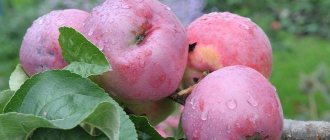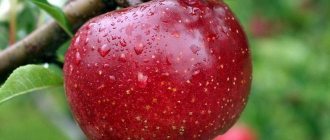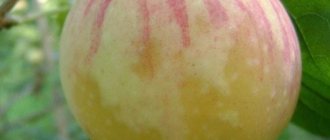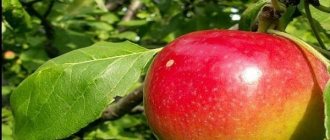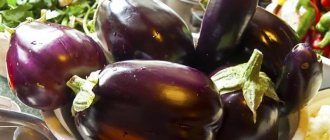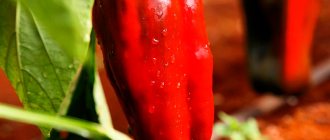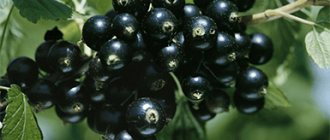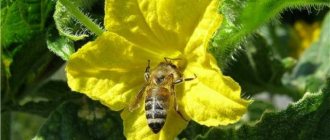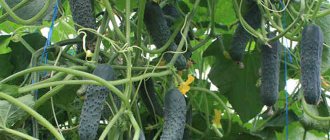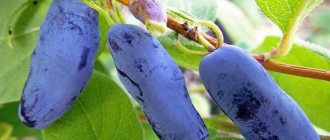The Orlik apple tree is a late-ripening variety. Such varieties are characterized by medium-sized fruits with juicy pulp and thick skin, which makes them suitable for all kinds of processing and long-term winter storage. “Orlik”, in addition to the listed advantages, has several more interesting qualities, which we will discuss in detail in the article.
The Orlik apple tree (pictured) demonstrates high productivity in its homeland - in the Oryol region
We present the main characteristics of the variety in a summarized form in the table:
| Parameter | Characteristic |
| Culture | Apple tree (Malus domestica Borkh.) |
| Variety | "Orlik" |
| Tree height | Medium height – 2-4 m (depending on the rootstock) |
| Terms of removable maturity | Late – mid-September |
| Consumption period | Winter - begins immediately after picking, the fruits are stored well until mid-February |
| Precociousness | High |
| Type of fruiting | Mainly on the rings |
| Productivity of an adult tree per season | High – up to 80-120 kg, periodic |
| Size and weight of fruits | Medium size, from 100 to 120 g |
| Shape and color | The apples are round in shape, slightly flattened or conical, with clearly defined large lobes. The color of the skin is uneven: light yellow with a blurred thick red blush and watercolor scarlet merging stripes. The entire surface of the fruit is covered with a shiny white waxy coating. Subcutaneous dots are small, numerous, gray, clearly visible |
| Fruit pulp | Juicy, dense, fine-grained, cream-colored with a greenish tint |
| Tasting assessment (taste qualities) | 4.4-4.6 points (out of 5) – sweet and sour taste with a strong aroma |
| Purpose of fruits | Dessert (universal) |
| Sustainability | Average winter hardiness (in the central and northern regions there is a risk of freezing without shelter). Moderately affected by scab |
| Year of inclusion in the State Register of the Russian Federation | 1986 |
| Recommended growing regions | Northwestern, Central and Central Black Earth |
| Originator | Federal State Budgetary Institution "All-Russian Research Institute of Breeding and Fruit Crops" (Oryol region) |
Origin and zoning
Domestic, proven variety. It was bred back in 1958 on the basis of the All-Russian Research Institute for Breeding Fruit Crops by famous specialists E. N. Sedov and T. A. Trofimova by hybrid crossing of popular varieties of the crop: “Mekintosh” and “Bessemyanka Michurinskaya”.
In the photo are the parent forms: “Mekintosh” (left) and “Semyanka Michurinskaya” (right)
In 1970, the seedlings identified as the elite were submitted for state testing, and 16 years later the variety was officially included in the State Register of Breeding Achievements of the Russian Federation and patented in 1998.
Due to its average winter hardiness, “Orlik” is zoned and recommended for industrial and amateur gardening in the North-Western, Central and Central Black Earth regions of our country. Thanks to a number of advantages and high ecological adaptability, this variety of apple tree is successfully grown in Ukraine, Belarus and other neighboring countries.
Climate and growing regions
This type of apple can withstand harsh winters very well. It also perfectly tolerates drought and any weather changes.
The variety was tested for cultivation in the Central, Central Chernozem regions, the Middle Zone, as well as in the North-Western District, but it is successfully grown in the southern regions, and in Siberia, and the Urals, however, if the winter temperature drops too low, The trunks of fruit trees must be insulated for the winter.
What will happen to your body if you drink rice water every day? Benefits of rice water
Description and characteristics of the plant
The trees are medium-sized, with a compact rounded crown. Skeletal branches extend from the trunk at right angles, with their ends directed upward. The bark on the trunk and main branches is smooth and yellowish. Fruits mainly on simple and complex ringlets, as well as on spears. The shoots are thick, straight, brown, heavily pubescent. The buds are appressed, medium in size, cone-shaped.
The flowering period occurs at the end of spring - beginning of summer
Large leaves are densely located on the shoot. The leaf blades are almost flat (slightly curved along the central vein), with a wrinkled surface, rich green in color with a grayish tint due to strong pubescence. They have a rounded-ovoid shape with coarsely wavy crenate edges and a sharply pointed bent tip. The flowers are large, in pink buds, the petals are light pink, closed, the stigma is below the anthers.
The variety is self-sterile and requires a pollinator, for example “Antonovka vulgaris”, “Welsey”, “Memory of the Warrior” or “Orlovskoe striped”.
Fruiting, growth and shape of the tree are always influenced by the rootstock on which the apple tree is grown. Plants on ordinary seed rootstocks begin to bear fruit in the 4th-5th year . In terms of the rate of increase in yield in young trees, “Orlik” is superior to such a fast-growing and productive variety as “Pepin saffron”, and trees aged 15-20 years produce yields of 80-120 kg per season. Plants on a dwarf rootstock are more resistant to low temperatures and produce large fruits (up to 130 g). However, they must be tied to a support and provided with painstaking care. According to experienced gardeners, specimens grown on semi-dwarf rootstocks have good frost and drought resistance.
Nuances for landing
Planting an apple tree is not difficult. For quality implementation, you should follow the recommendations of experienced gardeners.
When is the best time to plant
The best time to plant a seedling is September or October. Before the onset of cold weather, the young tree will have time to adapt to the environment and strengthen the rhizome.
How to choose and prepare a place for an apple tree
The best option is to plant on an elevated site. The location of groundwater should not be close to the roots of the plant. Due to excessive moisture, the seedling may rot.
A distance between apple trees of at least 2 m should be maintained. The area for planting is cleared of debris, rotten fruits, and dry branches. Prepare a soil mixture from several components:
- clay;
- sand;
- peat;
- humus;
- compost.
How to plant seedlings correctly
The stages of planting an Orlik seedling are simple to perform:
- Prepare the planting hole.
- Lower the apple tree stalk. Spread out the roots. Leave the root collar 7 cm above the ground. Sprinkle with a mixture of soil and fertilizer. Compact the planting.
- Water generously.
To ensure even growth of the tree, it is fixed using pegs, which are placed on both sides of the seedling.
Fruit characteristics
The apples are small in size, weighing about 100 g, maximum up to 120 g. The shape of the fruit is round, slightly flattened or slightly conical, with implicitly large lobes. A white waxy coating, giving a shiny whitish tint, appears on an unripe apple and remains until full ripeness. At the stage of removable ripeness, the fruits are greenish-yellow, during the period of consumption they become light yellow with a blurred, thick red blush and watercolor scarlet merging stripes. Subcutaneous dots are small, numerous, gray, and clearly visible.
There is a waxy coating on the surface of apples, giving it a whitish tint and pronounced shine.
The peduncle is short, thick, with an influx at the point of attachment to the fruit. The saucer is small, medium wide, slightly folded. The calyx is closed or semi-open. The funnel is small, floating, almost free of rust. Medium size heart. The seed chambers are closed, the seeds are ovoid, dark brown in color. The pulp is juicy, dense, fine-grained, cream-colored with a greenish tint. The taste is sweet and sour with a strong aroma. Professional tasting assessments of taste qualities are 4.4-4.6 points (out of 5), many summer residents describe the taste as “harmonious”, sweet with a refreshing sourness.
The biochemical composition of fruits largely depends on the soil and climatic conditions of the cultivation region. According to VNIISPK specialists, apples contain:
| Nutrients and beneficial substances | Quantity (per 100 g raw product) |
| Vitamin C (ascorbic acid) | 8.9 mg |
| Sahara | 11.0 g |
| Acids | 0.36 g |
| P-active substances | 167 mg |
| Pectins | 12.7 g |
Orlik apples have a dessert (universal) purpose - ideal for fresh consumption, canning and cooking.
Collection and storage
The fruits ripen simultaneously, usually in early autumn, for example in the Oryol region - in mid-September. The apples have an excellent presentation, but when fully ripe they crumble, like the mother’s Mekintosh. A distinctive feature of the variety is that the fruits are ready for consumption immediately after being picked from the tree. During long-term storage, they well preserve their high taste qualities along with their presentation.
Consumer ripeness, when the taste and juiciness of fruits are maximally revealed, occurs in November-December. The shelf life is 5-6 months (in the refrigerator - until March), in proper conditions the skin does not wrinkle, the integrity and wonderful taste of the fruit do not deteriorate.
Apples are often removed at the stage of technical ripeness to prevent them from falling off
The fruits are easily transported over long distances, so the variety is recommended primarily for commercial cultivation in intensive gardens and industrial processing.
Biological features of the Orlik apple tree
Getting to know this variety begins with considering the biological characteristics of the apple tree, its dimensions, yield and description of the fruit.
Description of the tree and the best pollinators
This apple tree variety has become widespread due to its compact size, which allows the tree to be planted even in a small area. The plant stretches up to a maximum of 5 m, the shape of its crown is neat, round, and of medium density. The branches are located at an angle of 90° from the trunk and have raised ends. The apple tree is distinguished by its high yield.
Being a self-sterile variety, Orlik needs pollination . By planting this tree with pollinating apple trees, you will ensure a high yield. If you only have a small area at your disposal and there is no desire to plant it only with apple trees, contact your neighbors and find out what varieties of apples they grow. Perhaps you can plant your tree next to a neighbor's pollinator.
To pollinate Orlik, it is enough to plant an apple tree next to Kandil Orlovsky, Solnyshok or Stroevsky. Aphrodite and Kurnakovskoe apple trees will also be good neighbors.
Find out about other fall apple tree varieties:
Description of fruits
The apples are small or medium in size, weigh from 120 to 200 g, and have a flattened conical shape.
Keratin hair straightening: photos, pros and cons
The expression of large lobes is weak. When ripe, the skin of apples acquires a light yellow and then a variegated red or scarlet hue. The pulp has a warm beige color, sometimes with a greenish coating. The structure of the pulp is quite dense, it is characterized by fine grain and juiciness. The aroma of apples of this variety is bright and rich.
The tasting rating of the taste of the presented variety is 4.5 on a five-point scale.
Orlik apples are recommended for consumption: for dietary purposes and for metabolic disorders in the body
Productivity
Orlik has won the love of gardeners for its early fruitfulness . The apple tree will bear fruit already in the fourth or fifth year after planting, and its yield will increase with each subsequent year. Thus, a tree at the age of 7-8 years can produce from 15 to 35 kg of apples, at 9-14 years old - from 50 to 80 kg, at 15-20 years old - from 80 to 120 kg.
Positive and negative points
Noting the advantages of the variety, professional gardeners and summer residents indicate among the valuable qualities of “Orlik”:
- excellent taste of fruits;
- high productivity;
- precociousness;
- long shelf life and the ability to transport fruit over long distances.
Depending on the soil and climatic conditions, the age of the trees and the intensity of agricultural technology, the yield averages 220 c/ha
Among the disadvantages it should be noted:
- average resistance to major diseases, in particular scab. Thus, during field tests at the Kaluga state variety plot in 2008-2009, VNIISKP specialists noted a high degree of scab damage to the leaves and fruits of Orlik at the level of 3.5 (out of 4) and 2 points, respectively;
- low winter hardiness of the plant - in conditions of a temperate continental climate (Kaluga region) in severe winters with a sharp drop in air temperature to −36 ℃, the total degree of freezing was 2.5 points;
- self-sterility;
- tendency to periodicity of fruiting and pre-harvest fruit drop.
Features of care
Apple tree care is based on standard agrotechnical measures. Planting is carried out taking into account the soil and climatic conditions of the region; for example, in central Russia with its early and harsh winters, spring planting is more justified. If the frequency of fruiting is violated, the plant is promptly fed and pruned. For prevention, trees are treated against pests and diseases.
Apple trees are quite unpretentious in care and respond well to standard agricultural technology
Most gardeners in reviews of the Orlik apple tree indicate average winter hardiness, which requires covering the trees. To do this, a month before the first frost, water the soil under the tree abundantly. The tree trunk circle is loosened and covered with a layer of peat. The trunk is whitened and wrapped in burlap. Young trees are sometimes tilted to the ground and covered with spruce branches. When snow falls, a snowdrift is poured around. In the spring, the snow is removed and the tree trunk circle is dug up.
To which regions is the variety more adapted?
The selection created on the basis of Bessemyanka Michurinskaya and Mekintosh is in high demand in industrial plantings, since the trees are easy to care for, they bear fruit well, the apples last a long time and are transported normally. The variety is also suitable for amateur farms. Most often it is found in the Central Black Earth, Central, and Northwestern regions. In general, the growth of a crop depends only on compliance with the requirements of agricultural technology, timely shelters for the winter, sufficient watering and fertilizers. Please note that with high air humidity, plantings require special care, since in this case the risks of diseases of fruits and leaves increase significantly. This article will tell you about the Agata tomato variety.
Before the onset of the winter season, remove the leaves under the trees to prevent pathogenic bacteria from infesting them.
Reviews from gardeners
Tatyana, 38 years old, Krasnodar
Favorite variety, growing in the garden for the eighth year. We pick the yellow-green fruits with a burgundy blush at the end of September, still a little unripe. The longer they sit, the better it tastes. In December they become very juicy and sweet. We wrap each apple in paper, put it in boxes and store it in the cellar until March. We make juices and compotes from the fallen ones - they turn out very tasty.
Marina, 59 years old, Tver region
Our apple tree is over 15 years old. He constantly pleases us with his harvests, producing an average of 60 kilograms annually. But the older you get, the more the fruits become smaller, and there is a tendency to bear fruit periodically. Unfortunately, in our region, during severe frosts, the tree froze several times. After harvesting, we try to water it abundantly, then cover the hole with peat, hole the trunk and wrap it in burlap. During snowy winters, we cover it with snow, making something like a snowdrift. This makes it easier for the apple tree to survive the winter. We make sure that the branches do not creep up, but grow to the sides. We shorten the top. In autumn, when the tree sheds its leaves, we remove dry branches and those that are not growing properly. Be sure to treat the cuts with garden varnish. The apples are very sweet and juicy! After collection, they are stored for almost six months.
Sergey, 54 years old, Birobidzhan
In our area, I planted seedlings in the spring; I was afraid that the roots of the two-year-old would immediately freeze. I fed it twice a year in spring and autumn. Be sure to cover it for the winter. To prevent the fruits from becoming smaller, I regularly trim and feed them (after picking the fruits, I sprinkle 300 g of superphosphate around the tree). True, in the summer in our area the hot weather lasts for weeks. Have to water frequently. As the apples ripen, their summer green-yellow color changes to autumn color - red with a whitish tint. The flesh is juicy, but the skin is tough. I like it better when the peel becomes softer, but this is already closer to February. In general, the variety suits me quite well.
